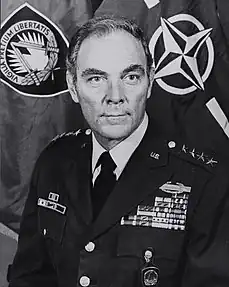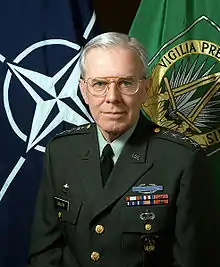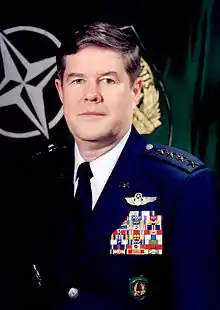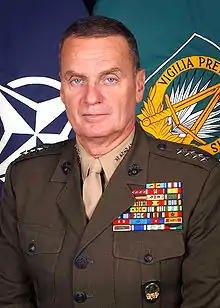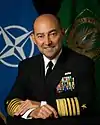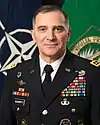| Supreme Allied Commander Europe | |
|---|---|
 SHAPE coat of arms | |
 Standard | |
| North Atlantic Treaty Organization Allied Command Operations (Supreme Headquarters Allied Powers Europe) | |
| Abbreviation | SACEUR |
| Reports to | North Atlantic Council, through NATO Military Committee |
| Residence | Chateau Gendebien |
| Seat | Casteau, Mons, Belgium |
| Nominator | President of the United States, with Senate advice and consent |
| Appointer | North Atlantic Council |
| Formation | 2 April 1951 |
| First holder | General of the Army Dwight D. Eisenhower |
| Website | shape.nato.int |
The Supreme Allied Commander Europe (SACEUR) is the commander of the North Atlantic Treaty Organization's (NATO) Allied Command Operations (ACO) and head of ACO's headquarters, Supreme Headquarters Allied Powers Europe (SHAPE). The commander is based at SHAPE in Casteau, Belgium. SACEUR is the second-highest military position within NATO, below only the Chair of the NATO Military Committee in terms of precedence.
SACEUR has always been held by a U.S. military officer, and the position is dual-hatted with that of Commander of United States European Command.
The current SACEUR is General Christopher G. Cavoli of the United States Army.
Role
An overview of NATO's military structures:
- Liaison: Provides advice and support to the NAC
Other Staffs and Commands Responsible to SACEUR:[2]
- NATO Airborne Early Warning Force
- Naval Striking and Support Forces NATO (U.S. Sixth Fleet)
References
- ↑ "NATO Secretary General at Allied Command Operations change of command". NATO. 1 July 2022. Retrieved 3 July 2022.
- ↑ "NATO Organization". 4 January 2024. Retrieved 15 January 2024.
List of holders

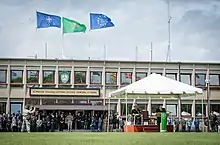
Since 2003 the Supreme Allied Commander Europe (SACEUR) has also served as the head of Allied Command Europe and the head of Allied Command Operations. The officeholders have been:[1]
| No. | Portrait | Supreme Allied Commander | Took office | Left office | Time in office | Defence branch |
|---|---|---|---|---|---|---|
| 1 | General of the Army Dwight D. Eisenhower (1890–1969) | 2 April 1951 | 30 May 1952 | 1 year, 58 days | ||
| 2 | General Matthew Ridgway (1895–1993) | 30 May 1952 | 11 July 1953 | 1 year, 42 days | ||
| 3 | General Alfred Gruenther (1899–1983) | 11 July 1953 | 20 November 1956 | 3 years, 132 days | ||
| 4 | General Lauris Norstad (1907–1988) | 20 November 1956 | 1 January 1963 | 6 years, 42 days | ||
| 5 | General Lyman Lemnitzer (1899–1988) | 1 January 1963 | 1 July 1969 | 6 years, 181 days | ||
| 6 | General Andrew Goodpaster (1915–2005) | 1 July 1969 | 15 December 1974 | 5 years, 167 days | ||
| 7 | General Alexander M. Haig Jr. (1924–2010) | 15 December 1974 | 1 July 1979 | 4 years, 198 days | ||
| 8 | General Bernard W. Rogers (1921–2008) | 1 July 1979 | 26 June 1987 | 7 years, 360 days | ||
| 9 | General John Galvin (1929–2015) | 26 June 1987 | 23 June 1992 | 4 years, 363 days | ||
| 10 | General John Shalikashvili (1936–2011) | 23 June 1992 | 22 October 1993 | 1 year, 121 days | ||
| 11 | General George Joulwan (born 1939) | 22 October 1993 | 11 July 1997 | 3 years, 262 days | ||
| 12 | General Wesley Clark (born 1944) | 11 July 1997 | 3 May 2000 | 2 years, 297 days | ||
| 13 | General Joseph Ralston (born 1943) | 3 May 2000 | 17 January 2003 | 2 years, 259 days | ||
| 14 | General James L. Jones (born 1943) | 17 January 2003 | 7 December 2006 | 3 years, 324 days | ||
| 15 | General Bantz J. Craddock (born 1949) | 7 December 2006 | 2 July 2009 | 2 years, 207 days | ||
| 16 | Admiral James G. Stavridis (born 1955) | 2 July 2009 | 13 May 2013 | 3 years, 315 days | ||
| 17 | General Philip M. Breedlove (born 1955) | 13 May 2013 | 4 May 2016 | 2 years, 357 days | ||
| 18 | General Curtis Scaparrotti (born 1956) | 4 May 2016 | 3 May 2019 | 2 years, 364 days | ||
| 19 | General Tod D. Wolters (born 1960) | 3 May 2019 | 4 July 2022 | 3 years, 62 days | ||
| 20 | General Christopher G. Cavoli (born c. 1965) | 4 July 2022 | Incumbent | 1 year, 196 days |
Deputy
The position of Deputy Supreme Allied Command Europe (DSACEUR) has been known as Deputy Head of Allied Command Operations since 2003. From January 1978 until June 1993 there were two DSACEURs, one British and one German. From July 1993 this reverted to a single DSACEUR. With a small number of exceptions who were German military officers, DSACEUR is normally a British military officer. The officeholders have been as follows:
| No. | Portrait | Deputy Supreme Allied Commander | Start of term | End of term | Branch | Unit of Commission |
|---|---|---|---|---|---|---|
| 1. |  |
Field Marshal | 2 April 1951 | 23 September 1958 | Royal Warwickshire Regiment | |
| 2. |  |
General | 23 September 1958 | 22 September 1960 | Worcestershire Regiment | |
| 3. |  |
General | 22 September 1960 | 1 January 1964 | Royal Welch Fusiliers | |
| 4. |  |
Marshal of the Royal Air Force | 1 January 1964 | 1 March 1967 | N/A | |
| 5. |  |
General | 1 March 1967 | 1 December 1970 | Duke of Wellington's (West Riding) Regiment | |
| 6. | General | 1 December 1970 | 12 November 1973 | 1st The Royal Dragoons | ||
| 7. |  |
General | 12 November 1973 | 12 March 1976 | Oxfordshire and Buckinghamshire Light Infantry | |
| 8. | General | 12 March 1976 | 2 November 1978 | Royal Artillery | ||
| 9. | General | 3 January 1978 | 1 April 1980 | - | ||
| 10. | General | 2 November 1978 | 9 April 1981 | 2nd Dragoon Guards (Queen's Bays) | ||
| 11. |  |
Admiral | 1 April 1980 | 1 April 1982 | N/A | |
| 12. | Air Chief Marshal | 9 April 1981 | 16 July 1984 | N/A | ||
| 13. |  |
General | 1 April 1982 | 2 April 1984 | - | |
| 14. | General | 2 April 1984 | 1 October 1987 | Bundesgrenzschutz | ||
| 15. | General | 16 July 1984 | 26 June 1987 | Royal Artillery | ||
| 16. | General | 26 June 1987 | 17 January 1990 | Northamptonshire Regiment | ||
| 17. | General | 1 October 1987 | 2 October 1990 | N/A | ||
| 18. | General | 17 January 1990 | 5 April 1993 | 4th Queen's Own Hussars | ||
| 19. | General
Dieter Clauss |
2 October 1990 | 1 July 1993 | - | ||
| 20. | General | 5 April 1993 | 12 December 1994 | Gloucestershire Regiment | ||
| 21. | General | 12 December 1994 | 30 November 1998 | Queen’s Own Highlanders | ||
| 22. | General | 30 November 1998 | 17 September 2001 | Parachute Regiment | ||
| 23. | General | 17 September 2001 | 18 September 2002 | Panzergrenadier | ||
| 24. | Admiral | 18 September 2002 | 1 October 2004 | N/A | ||
| 25. | .JPG.webp) |
General | 1 October 2004 | 22 October 2007 | Parachute Regiment | |
| 26. | .jpg.webp) |
General | 22 October 2007 | March 2011 | Royal Anglian Regiment | |
| 27. | .jpg.webp) |
General | March 2011 | March 2014 | 14th/20th King's Hussars | |
| 28. | 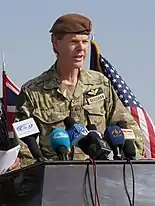 |
General | March 2014 | March 2017 | 14th/20th King's Hussars | |
| 29. |  |
General | March 2017 | April 2020 | 17th/21st Lancers | |
| 30. |  |
General | April 2020 | July 2023 | The Light Infantry | |
| 31. | .jpg.webp) |
Admiral | July 2023 | Incumbent | Fleet Air Arm |
Role in intra-European defence integration
SACEUR's planned role for the European Defence Community
If the treaty founding the European Defence Community (EDC) had not failed to acquire ratification in the French Parliament in 1954, the EDC would have entailed a pan-European military, divided into national components, and had a common budget, common arms, centralized military procurement, and institutions. The EDC would have had an integral link to NATO, forming an autonomous European pillar in the Atlantic alliance. The following chart illustrates the role of SACEUR in such an arrangement.

DSACEUR's role in European Union missions
Under the 2002 Berlin Plus agreement, SHAPE may take part in the European Union's (EU) command and control structure as an operational headquarters (OHQ) for EU missions. In such an instance, the Deputy Supreme Allied Commander Europe (DSACEUR), who is always a European, would serve as Operation Commander (OpCdr). This use of SHAPE by the EU is subject to a "right of first refusal", i.e. NATO must first decline to intervene in a given crisis,[2][3] and is contingent upon unanimous approval among NATO states, including those outside of the EU.[4]
See also
References
- ↑ List of Former SACEURs
- ↑ "EU Operations Centre".
- ↑ The Heritage Foundation report, March 24, 2008.
- ↑ Bram Boxhoorn, Broad Support for NATO in the Netherlands, 21-09-2005, "Article". Archived from the original on 18 February 2007. Retrieved 19 August 2007.

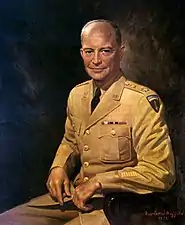
.jpg.webp)

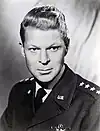
.jpg.webp)

